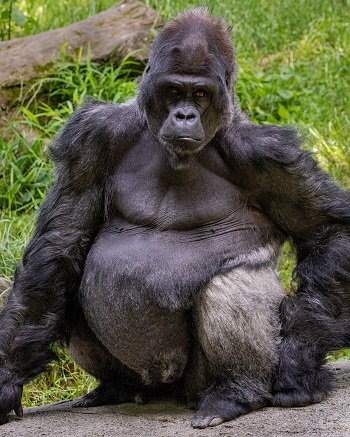
The silverback gorilla, known for its impressive size and strength, is a magnificent creature that captivates both wildlife enthusiasts and conservationists alike. These remarkable primates are part of the great ape family and play a vital role in the ecosystems they inhabit. In this article, we will delve into the normal and record sizes of silverback gorillas, their interactions with humans, and their crucial role in the environment.
Normal and Record Sizes
Silverback gorillas are the largest and most dominant members of the gorilla species. Their name comes from the striking silver-gray hair that develops on their backs as they age. Here are some facts about their sizes:
Average Size: Adult male silverbacks typically stand between 5.6 to 5.9 feet tall when standing upright. They can weigh anywhere from 300 to 500 pounds.
Record Size: The largest recorded silverback gorilla, named “Phil,” weighed an astonishing 905 pounds and stood at 5.9 feet tall. This remarkable specimen lived in captivity in the United States.
Interactions with Humans
Behavior Toward Humans: In the wild, silverback gorillas are generally shy and non-aggressive toward humans. They are known to be peaceful creatures, often avoiding human contact when possible.
Conservation Efforts: Human activities, such as habitat destruction and poaching, have posed significant threats to silverback gorilla populations. Conservation organizations and researchers are working tirelessly to protect these primates. Efforts include establishing protected areas, conducting anti-poaching patrols, and educating local communities about the importance of gorilla conservation.
Tourism: In some regions, gorilla tourism has become an important source of revenue for local economies. Sustainable tourism practices, such as limited group sizes and controlled visitor interactions, have been implemented to minimize the impact on gorillas while supporting conservation efforts.
Role in the Environment
Silverback gorillas play a vital role in their ecosystems:
Seed Dispersal: Gorillas are frugivores, primarily consuming fruits and plants. As they travel through their habitats and digest these foods, they inadvertently spread seeds. This process helps maintain plant diversity and regenerate forests.
Ecosystem Engineers: By creating clearings and paths in the dense forest underbrush, gorillas shape their environment. These clearings can benefit other species by providing easier access to resources like food and water.
Indicator Species: The health of gorilla populations often reflects the overall health of the ecosystem they inhabit. Monitoring the well-being of gorillas can serve as an indicator of the broader conservation needs of the region.
Conservation Challenges
While silverback gorillas are essential to their ecosystems, they face numerous threats:
Habitat Loss: Deforestation, driven by logging and agriculture, is rapidly reducing gorilla habitat.
Poaching: Gorillas are targeted for their meat, and infant gorillas are often captured for the illegal pet trade.
Disease: Gorillas are susceptible to diseases, including those transmitted by humans. Encounters with tourists and researchers can increase the risk of disease transmission.
Conclusion
The silverback gorilla is a remarkable and essential species, contributing to the balance and diversity of its ecosystem. Their impressive size, peaceful demeanor, and role as seed dispersers make them a vital part of the natural world. To ensure the survival of these incredible creatures, it is crucial that we continue to support conservation efforts, protect their habitats, and promote responsible tourism practices that allow us to observe and appreciate these majestic animals while minimizing our impact on their fragile populations.
Related Articles & Free Email Newsletter Sign Up
Majestic Predators of the Night: The Great Horned Owl
Meet the World’s Largest Reptile: The Saltwater Crocodile
The Reticulated Python: A Majestic Serpent with Ecological Consequences




Comment here